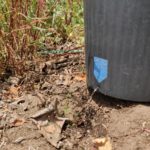The One-Finger Test
In the Community Garden at Holy Nativity, we used what we call “the one finger test.” That means you take your finger and stick it into the garden soil – about one inch down into the soil. The soil down there should feel moist, like a wrung-out sponge. If the soil feels moist, your plants in that location don’t need watering today.
The one-finger test means getting your hands into the soil. That means the real dirt, beneath the mulch. This measurement isn’t about whether the mulch is wet, nor about whether the interface plane between mulch & soil surface is moist, but the condition of the garden soil 1″ into the soil.
For new gardens (and during a drought), soil surface tension can be an issue, particularly with our sandy soils in Westchester. If there is no mulch on the surface of a new garden, often times the sand particles seem to lock together. Water applied on top simply rolls right off, and the underlying plant is gasping for water. Again, the test is the condition 1″ down. If water is running off the surface, some tricks to use include (1) using a hand rake to gently break up the surface of the soil; (2) using basins, gardening in a depression, using mini dams or earth forms to hold the water in place long enough so that it can infiltrate; (3) enriching the soil with compost — preferably coarse, homemade — which acts like a sponge to hold moisture, plus provides food for the soil organisms that make up the real richness of organic garden soil; (4)applying mulch, to break the soil tension, enrich the soil at the soil/mulch interface, and keep the soil cooler.
In clay soils, for instance in parts of Culver City, surprisingly enough, the solution is again enriching the soil with compost. A rich garden soil has less moisture-regulation issues. In very heavy clay soils, rather than gardening in a depression, for winter gardens you might need to consider using a raised bed. I’m hesitant to mention raised beds because they get tremendous kudos in East Coast and English garden books, but they aren’t really right for Southern California. Here, a raised bed means that the block of soil is exposed to baking summer heat and drying air on five sides instead of just one. For sandy soils, raising your beds is not at all recommended (unless you have soil toxin/lead issues, but that’s an entirely different topic). Thus the first thing try is really building up that rich, healthy, alive garden soil to see if that helps your moisture-regulation issues.
In new gardens, these issues are compounded by the fact that compost cycles and soil life populations are not yet established. Some portions of a new garden might have received better tilling or more compost than other sections. Thus there is no other alternative than to use the one-finger test many, many times in different spots around the garden. Over time, observation will teach you about the condition of the soil. A hypothetical example: the spot by the fig is consistently dry every time you try it, while the lavender always seems to be wet. You’ll learn, through many observations over time, that on a rushed day you can water that fig and skip that lavender. Probably both spots will need some chunky high-organic-material compost mixed in.
Some plants — most notably our California natives, our “drought tolerant” or “xeriscape” plants, and most citrus trees (oranges, lemons, and their cousins) — don’t like to be moist all the time. They like a chance to dry out between waterings. Thus if your one-finger test reveals any soil moisture at all for these plants, do not water them. Very often these are the plants we “kill with kindness” by overwatering. You can observe the overwatering conditions in plants like lavender and sage when they put on excessive amounts of lush new growth with broad leaves and a rich green aesthetic — that’s not normal. Their normal leaf is supposed to be slow-growing, grey-green, and a bit lean-looking. Plants in this category include (but are not limited to) most California natives, most sages including hybrids, lavender, rosemary, Mediterranean herbs like oregano and thyme, plants of Middle Eastern origin like pomegranates. In the Community Gardens, we are using a set of signs to mark these water-sensitive plants. Citrus trees that are overwatered tend to turn yellow and drop their leaves abundantly. Again, if your one-finger test reveals any soil moisture at all, do not water them.

